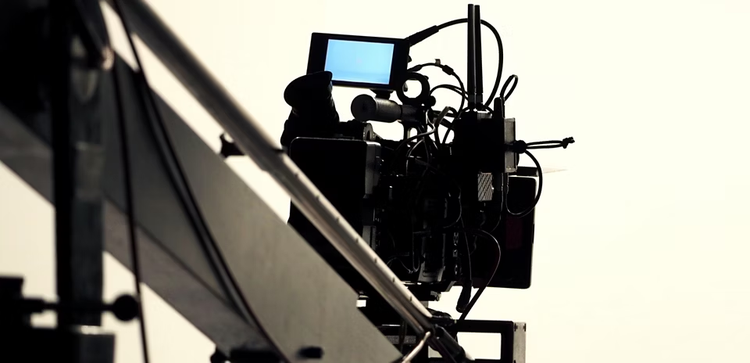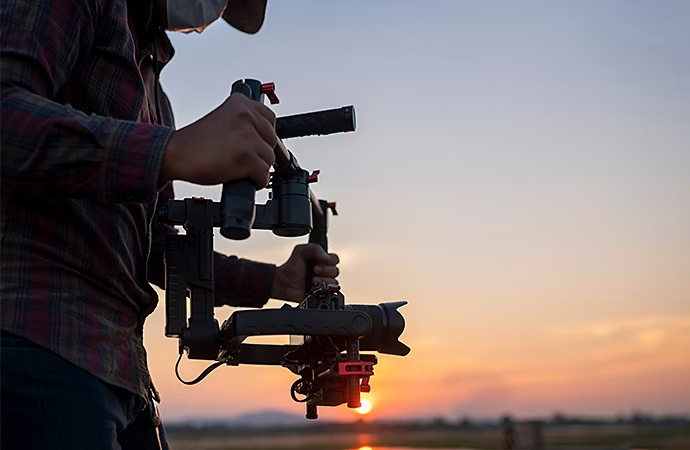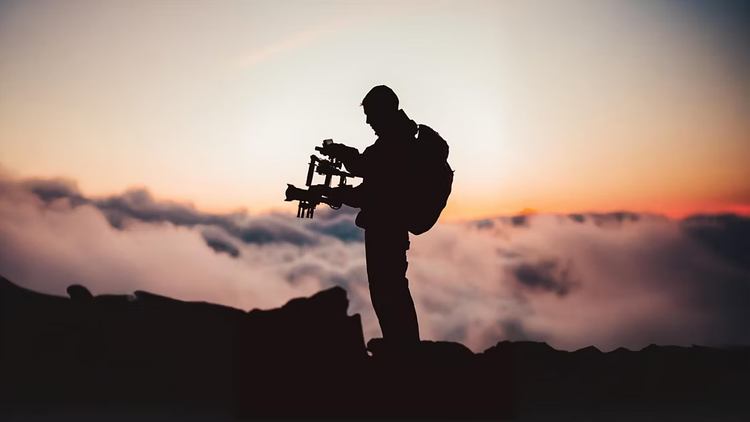Adobe Premiere
Everything you need to know about the tracking shot.
Discover how you can use tracking shots to set the scene, introduce characters, and connect with your audience in a whole new way.

What is a tracking shot?
While often used interchangeably, there are subtle differences between a tracking shot and a dolly shot. A tracking shot refers to any shot where the camera follows a subject; a dolly shot involves the camera being mounted on a wheeled platform (a dolly) that can move in any direction. All dolly shots are tracking shots, but not all tracking shots use a dolly.
Tracking shots in the early days of cinema required large, heavy cameras mounted on cumbersome tracks, limiting movement to relatively simple paths. Modern digital cameras are much lighter and more portable, allowing for greater flexibility in movement. This enables filmmakers to execute more complex types of shots, such as handheld tracking, where the camera follows a subject through tight spaces and uneven terrain.
What makes a good tracking shot.
One of many different types of camera shots, the tracking shot is a versatile tool that helps filmmakers tell stories and communicate with their audiences. Some of the best tracking shots in cinema history set the pace of the film, convey strong emotions, and introduce the characters.
In The Shining, Stanley Kubrick used a long tracking shot to create tension and dread as Danny, the main child character, rides a plastic trike through the winding corridors of the haunted hotel. Alternately, director Sam Mendes composed his film 1917 entirely of tracking shots, taking the audience on a visceral, immersive journey through the trenches of World War I.
Historically, tracking shots used a mechanism called a camera dolly that ran on a track. Dolly shots allowed the camera to smoothly move forward and backward through space (called dolly in and dolly out). “As popular as tracking shots have been,” notes cinematographer Paulius Kontijevas, “it’s probably even more popular now since we have equipment that's lighter and more affordable.” With a Steadicam or gimbal device, smooth camera movements are easier to achieve than ever before.
A memorable tracking shot doesn't just follow the action; it amplifies the story or emotion of the scene. Memorable movement feels essential to the narrative. For example, it might reveal important details about the characters, creating a deeper connection with them.
Elements of a good tracking shot in film include:
- A clear focus on the subject
- Smooth, fluid motion
- Purposeful movement that enhances the story
- Technical precision in focus and framing
- Emotional impact or mood enhancement
- Seamless integration with the overall narrative.


How to shoot a tracking shot.
Preparation is important when planning any video shoot, but tracking shots require an extra level of planning and practice. The most challenging aspect is coordinating the camera's movement with the actors, lighting changes, and any moving elements in the scene. Often these shots use a Steadicam, as even a slight misalignment can easily ruin the shot.
1. Create a shot list
For any tracking shot to be successful, you want to understand when and where you want to use that shot. Rather than throwing a random tracking shot into your video, consider where it can be most effective from a storytelling perspective and how it will help your audience connect with your characters. You need to be purposeful about your planning, so build a shot list and decide where it will go in your video and where it will fit during your production process.
2. Gather your equipment.
Now you need to determine what kind of equipment you need. While you probably don’t need a full dolly and track setup, you will need a camera stabilizer like a gimbal or Steadicam. This ensures smooth camera movement and stable footage that’s easier to edit in post-production. If the equipment is new to you, be sure to practice with your gear. You can limit mistakes that might occur while filming by getting more comfortable with the setup ahead of time.
3. Research and rehearse.
Don’t show up on the day of shooting without first scoping out the environment. You’ll need to place physical markers on the set to indicate where your actors will travel as well as the path your camera operator needs to follow to keep everything in focus. If your scene includes extras, make sure everyone knows where they need to be at the start and the end of the shot.
Rehearsal and communication are key, especially if you have special effects, moving vehicles, or choreography of any kind. Keep in mind that even if everything goes perfectly, you’ll probably need to do a few takes to make sure everyone hits their mark..

Polish your tracking shots in post-production.
Once you’ve captured your footage, it’s time to enter the next phase of production and edit your shot with Adobe Premiere Pro. Premiere Pro helps stabilize shaky footage using Warp Stabilizer in post-production. Filmmakers can take more creative risks during shooting, knowing that the tool will help them correct minor issues.
Stabilization techniques.
In-camera stabilization:
- Use a gimbal or Steadicam for smooth handheld movement
- Employ a dolly on tracks for consistent, linear motion
- Utilize a camera slider for short, precise movements.
Post-production stabilization in Premiere Pro.
Apply the Warp Stabilizer effect:
- Select your clip and go to Effects > Distort > Warp Stabilizer.
- Adjust settings like smoothness and method (position, position/scale/rotation).
- Use the Rolling Shutter Repair effect for CMOS sensor artifacts.
- Manually keyframe position and rotation for fine-tuned adjustments.
Optical flow interpolation.
Use Premiere Pro's Optical Flow feature to create smoother slow-motion from your tracking shots.
Nested sequence stabilization.
For complex shots, nest your sequence and apply stabilization to the nested sequence.
Organizing your footage.
Implement a clear folder structure:
- Create main folders for each project.
- Add subfolders for different shooting days or locations.
- Use separate folders for raw footage, audio, and assets.
Use consistent naming conventions:
- Include the date, scene number, and take number in filenames.
- Example: "20240816_Scene05_Take03_TrackingShot.mp4"
Utilize Premiere Pro's organizational tools:
- Create bins for different types of shots (wide shots, tracking, close-ups).
- Use labels and color coding to quickly identify tracking shots.
- Add metadata tags for easy searching and filtering.
Create proxy files for smoother editing:
- Generate lower-resolution proxy files for complex tracking shots.
- Link these to your high-res footage for faster editing in post-production.
Use sequence markers:
- Add markers to your timeline to note key moments in tracking shots.
- Use different colored markers for various purposes (e.g., stabilization needed, VFX required).
Regular backups:
- Implement a robust backup system to protect your footage and project files.
- Consider cloud storage for additional security and team collaboration.
Explore the versatility of tracking shots.
The rise of 360-degree video has influenced camera tracking shot techniques, enabling filmmakers to create fully immersive experiences where viewers can choose their own perspectives. Tracking shots in 360-degree environments allows for innovative storytelling, where the audience can explore the scene in all directions while the camera moves through it.
There’s more than one way to use tracking shots in film projects. Whether it’s a crane shot or a close-up, point-of-view clip, tracking shots can help directors bring their story to life in a new way.
The lazy cadence of the opening scene of Joe Wright’s Pride & Prejudice brings the audience into the relaxed, though occasionally hectic, country home of the Bennet family. Alternately, director Alfonso Cuarón uses several long-take tracking shots to traverse chaotic, violent environments in his film Children of Men.
“People are experimenting with the tracking shot where they see how fast the camera can move and how fast we can track,” says Kontijevas. From action scenes to quiet, emotional moments, tracking shots can be used to set the pace of film.
Create seamless transitions.
Tracking shots are an innovative way to transition between environments and follow a character on their journey. In Martin Scorsese’s Goodfellas, the audience is brought along for the ride while notorious mobster Henry Hill introduces his future wife Karen to the lavish lifestyle of the Mafia underworld. Moving from an establishing shot outside of the club, through the busy kitchen, and into the crowded restaurant, the viewer is immersed in this world of luxury alongside the characters.
Tell a vivid story.
Tracking shots allow you to experiment with perspective and bring your story to life through the eyes of your protagonist.
At the climax of Selma, Ava DuVernay uses subtle tracking shots to dolly out and follow Martin Luther King, Jr. and the other marchers as they cross the Edmund Pettus Bridge. This gives the viewer an unimpeded look at the concern and trepidation on the marchers’ faces as they approach the potential violence that awaits them on the other side. These intimate, moving shots bring the audience and the characters close together in a new way.
Convey complex emotion.
Showing an individual character’s emotional state or the overall mood of a scene is another great use of tracking shots.
In Emerald Fennell’s Promising Young Woman, the main character’s frustration is vividly brought to life as the camera moves and follows her in a circle around a truck as she smashes the headlights and windshield. This puts the audience in the perspective of the moving subject, rather than as a bystander to the action. Tracking shots are all about movement, but the subject matter and setting inherently affect how that movement is captured and interpreted.

Watch these 7 great tracking shots.
Check out the famous tracking shots mentioned above, and explore how different directors used the same tool to achieve vastly different artistic results.
1. The Shining (1980), directed by Stanley Kubrick
This famous film uses tracking shots several times to build tension and suspense.
2. 1917 (2019), directed by Sam Mendes.
This film is shot and edited to look like one long tracking shot. The shortest shot in the movie is 39 seconds long, while the longest continuous tracking shot is eight and half minutes long.
3. Pride & Prejudice (2005), directed by Joe Wright.
Again, there are several notable tracking shots in the film, and each serves its own purpose — from exploring busy, bustling ballrooms to luxuriating in quiet mornings in a country estate.
4. Children of Men (2006), directed by Alfonso Cuarón.
There are three noteworthy tracking shots in this film, with the shortest running just over a minute and the longest clocking in at nearly six and a half minutes long. All of these shots are full of action and moving vehicles.
5. Goodfellas (1990), directed by Martin Scorsese.
The immersive tracking shots in this film introduce the characters and the audience to the luxurious life of modern-day mobsters.
6. Selma (2014), directed by Ava DuVernay.
Keep in mind that the tracking shots used in this film are often only several seconds long, but the moving camera following the movements of characters on screen immerses the audience in the action in a unique way.
7. Promising Young Woman (2020), directed by Emerald Fennell.
Keep in mind that the tracking shots used in this film are often only several seconds long, but the moving camera following the movements of characters on screen immerses the audience in the action in a unique way.
Tracking shots are an eye-catching way to break up the pacing in your next video while giving your audience a new perspective. Whether you want to bring your viewer into a new world or share an unlikely point of view, camera tracking shots can help you do it. So try your hand at tracking shots and bring your videos to life with Premiere Pro.